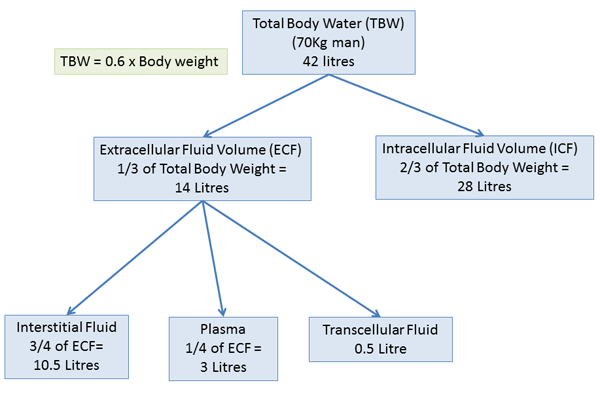Page created on October 7, 2019. Last updated on December 18, 2024 at 16:55
Blood
The volume of the plasma is around 3 litres in an average person, but the average blood volume is 4-6 litres. That’s because the blood contains many cells and proteins that contribute to the blood volume. If a person has too little blood volume, he has hypovolaemia, and if he has too much he has hypervolaemia.
The blood has many functions:
- Transports important molecules to and from cells
- Nutrients to cells
- Oxygen to cells
- Waste products from cells (urea, CO2)
- Regulate body temperature by altering blood flow through the skin
- Regulate pH, because the plasma contains acid-base buffers
- Protection against pathogens, because it carries the white blood cells and other components of the immune system around
- Transports endocrine hormones around, allowing communication between cells
- Protect against bleeding by clotting
The blood can be divided into two parts: The plasma and the cellular elements.
Cellular elements
The cellular elements comprise 45% of the total blood volume. You should know which cells are present in the blood and in what number.
| Cell type | Number |
| Red blood cell (RBC) | 4.5 – 5.5 million/µL |
| White blood cell (WBC) | 4 000 – 11 000/µL |
| Neutrophils | 60% of all WBCs |
| Lymphocytes | 35% of all WBCs |
| Monocytes | 5% of all WBCs |
| Eosinophils | 3% of all WBCs |
| Basophils | 0-1% of all WBCs |
| Platelets | 150 000 – 400 000/µL |
A good way to remember the order of white blood cells in decreasing order from most abundant to least abundant is the pneumonic never let monkeys eat bananas. N – L – M – E – B.
Body fluid compartments
The body is 60% water. That fluid is divided into two major compartments, the intracellular compartment, which includes all the water inside the cells, and the extracellular compartment, which includes all the water outside the cells. These compartments are best illustrated as a tree:
- Intracellular fluid compartment (fluid inside cells)
- Extracellular fluid compartment (fluid outside cells)
- Interstitial fluid (fluid in the interstitial space, the space that is between cells in a tissue)
- Plasma fluid/intravasal fluid (fluid inside the blood vessels)
- Transcellular fluid (not important right now)
Or as an image:

These volumes vary from person to person, but they’re approximately the same in everyone who have average bodies. It’s easy to remember how much each fluid volume weighs with the 60 – 40 – 20 rule. 60% of the body’s weight is water (total body water). 40% of the body’s weight is intracellular water and 20% of the body’s weight is extracellular water.
We can measure the sizes of different fluid compartments of a person by administering certain compounds intravenously. If we give inulin to a person inulin will distribute itself into the whole extracellular fluid space. If we know how much we give, and later measure the concentration of inulin in the plasma we can calculate the volume of the extracellular space. This formula shows how:
Volume = Mass / Concentration
In other words, the volume of the extracellular fluid space is equal to the mass of inulin administered divided by the concentration of inulin in the extracellular fluid after inulin has distributed itself.
By using different compounds which distribute in different fluid compartments we can use the same method to measure the volume of the different fluid compartments. Here are the different compounds that can be used and which fluid compartment they can be used to measure the size of:
- Heavy water (D2O) – used to measure total body water
- Inulin – used to measure extracellular space
- Evans-blue – used to measure plasma volume